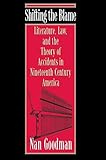Shifting the Blame : Literature, Law, and the Theory of Accidents in Nineteenth-Century America / Nan Goodman.
Material type: TextPublisher: Princeton, NJ : Princeton University Press, [2022]Copyright date: ©1998Description: 1 online resource (224 p.) : 6 halftonesContent type:
TextPublisher: Princeton, NJ : Princeton University Press, [2022]Copyright date: ©1998Description: 1 online resource (224 p.) : 6 halftonesContent type: - 9780691227450
- Accident law -- United States -- History -- 19th century
- Accidents in literature
- American literature -- 19th century -- History and criticism
- Blame in literature
- Law and literature -- History -- 19th century
- Legal stories, American -- History and criticism
- Negligence in literature
- Responsibility in literature
- LITERARY CRITICISM / American / General
- Adams, Henry
- Armstrong, John
- Banta, Martha
- Bercovitch, Sacvan
- Blumin, Stuart
- Boorstin, Daniel
- Cardozo, Benjamin
- Cole, John
- Cover, Robert
- Crane, Stephen
- Dane, Nathan
- DeVoto, Bernard
- Dimock, Wai Chee
- Eisenberg, Melvin Aron
- Fiss, Owen
- Flanders, Henry
- Freud, Sigmund
- Friedman, Lawrence
- Gallagher, Catherine
- Giedion, Siegfried
- Goldberg, Reuben Lucius
- Goodrich, Peter
- Hacking, Ian
- Harr, Jonathan
- Heisenberg, Werner
- Horwitz, Howard
- Howells, William Dean
- Jehlen, Myra
- Kaplan, Justin
- King, Stephen
- Lauck, W. Jett
- Levy, Leonard
- Locke, John
- Marx, Karl
- Michelson, Bruce
- Nelson, William
- Oliver, Benjamin
- Paine, Albert
- Palmer v. Mulligan (1805)
- Philbrick, Thomas
- Rousseau, Jean-Jacques
- Seltzer, Mark
- Stratton, George M
- Tichii, Cecelia
- Walce, James
- Weiner, Philip P
- Weisberg, Richard
- Whiting, Frank
- common law and custom
- contracts
- property law
- responsibility
- 810.9/355 21
- PS217.A25
- online - DeGruyter
| Item type | Current library | Call number | URL | Status | Notes | Barcode | |
|---|---|---|---|---|---|---|---|
 eBook
eBook
|
Biblioteca "Angelicum" Pont. Univ. S.Tommaso d'Aquino Nuvola online | online - DeGruyter (Browse shelf(Opens below)) | Online access | Not for loan (Accesso limitato) | Accesso per gli utenti autorizzati / Access for authorized users | (dgr)9780691227450 |
Browsing Biblioteca "Angelicum" Pont. Univ. S.Tommaso d'Aquino shelves, Shelving location: Nuvola online Close shelf browser (Hides shelf browser)

|

|

|

|

|

|

|
||
| online - DeGruyter Divided We Stand : American Workers and the Struggle for Black Equality / | online - DeGruyter Practices and Principles : Approaches to Ethical and Legal Judgment / | online - DeGruyter Constitutional Politics : Essays on Constitution Making, Maintenance, and Change / | online - DeGruyter Shifting the Blame : Literature, Law, and the Theory of Accidents in Nineteenth-Century America / | online - DeGruyter Prolegomena to the Study of Greek Religion / | online - DeGruyter Bold Relief : Institutional Politics and the Origins of Modern American Social Policy / | online - DeGruyter Weaving Self-Evidence : A Sociology of Logic / |
Frontmatter -- Contents -- Acknowledgments -- CHAPTER ONE Introduction -- CHAPTER TWO A Clear Showing THE PROBLEM OF FAULT IN JAMES FENIMORE COOPER'S THE PIONEERS -- CHAPTER THREE Negligence before the Mast SHIP COLLISIONS AND THE NAUTICAL LITERATURE OF THE MID-NINETEENTH CENTURY -- CHAPTER FOUR "Nobody to Blame" STEAMBOAT ACCIDENTS AND RESPONSIBILITY IN TWAIN -- CHAPTER FIVE The Law of the Good Samaritan CROSS-RACIAL RESCUE IN STEPHEN CRANE AND CHARLES CHESNUTT -- CHAPTER SIX Stop, Look, and Listen THE SIGNS AND SIGNALS OF THE RAILROAD ACCIDENT -- CHAPTER SEVEN Epilogue -- Notes -- Index
restricted access online access with authorization star
http://purl.org/coar/access_right/c_16ec
Drawing on legal cases, legal debates, and fiction including works by James Fenimore Cooper, Mark Twain, Stephen Crane, and Charles Chesnutt, Nan Goodman investigates changing notions of responsibility and agency in nineteenth-century America. By looking at accidents and accident law in the industrializing society, Goodman shows how courts moved away from the doctrine of strict liability to a new notion of liability that emphasized fault and negligence. Shifting the Blame reveals the pervasive impact of this radically new theory of responsibility in understandings of industrial hazards, in manufacturing dangers, and in the stories that were told and retold about accidents. In exciting tales of the actions of "good Samaritans" or of sea, steamboat, or railroad accidents, features of risk that might otherwise escape our attention--such as the suddenness of impact, the encounter between strangers, and the debates over blame and responsibility--were reconstructed in a manner that revealed both imagined and actual solutions to one of the most difficult philosophical and social conflicts in the nineteenth-century United States. Through literary and legal stories of accidents, Goodman suggests, we learn a great deal about what Americans thought about blame, injury, and individual responsibility in one of the most formative periods of our history.
Mode of access: Internet via World Wide Web.
In English.
Description based on online resource; title from PDF title page (publisher's Web site, viewed 29. Jun 2022)


